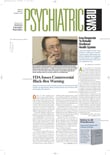Major depression is undertreated among homebound elderly, but especially so among black homebound elderly, according to a report in the October American Journal of Geriatric Psychiatry.
But the same study found, surprisingly, that the prevalence of major depression did not differ significantly among black and white homebound elderly.
Previous studies of depression and racial disparities among seniors have provided conflicting evidence. Some studies have found higher rates of depression among older white adults, others have found lower rates in that group, while still others have reported no difference by racial group.
Study author Denise Fyffe, Ph.D., said the contradictory findings could stem from a failure to focus on black and white patients with similar medical conditions, given the strong association between illness and physical impairment and late-life depression.
She is a postdoctoral fellow at the Institute for the Elimination of Health Disparities at the University of Medicine and Dentistry of New Jersey's School of Public Health.
The data came from a study conducted by Martha Bruce, Ph.D., M.P.H., at Weill Medical College of Cornell University. The study was funded by the National Institute of Mental Health.
A random sample of 56 black and 458 white homecare patients aged 65 and over was drawn from a log of newly admitted patients to the Visiting Nurses Service in Westchester, a not-for-profit certified home health agency serving a 450-square-mile county north of New York City. A diagnosis of major depressive disorder (MDD) was determined by a trained research assistant using the Structured Clinical Interview for Axis I Diagnosis.
Similar prevalence rates of MDD were found across black patients (10.7 percent) and white patients (10.9 percent). Statistical analysis showed no significant racial differences in the prevalence of MDD after controlling for potential confounding variables, including education, poverty level, and cognitive functioning as assessed by the Mini-Mental State Exam.
Similarly, the percentage of patients reporting each of the DSM-IV depressive symptoms did not differ by race. Additional statistical analysis revealed no significant difference by race in any of the symptoms, after adjusting for the overall severity of depression as measured by the Hamilton-Depression Rating Scale.
Only one of the six depressed black patients (16.7 percent) received antidepressant medications, versus 32 percent of the white depressed patients.
Fyffe and colleagues acknowledged that the small size of the sample may account for the lack of a finding of racial disparity. But they say the finding may also represent a true “shared burden” of MDD among black and white elderly homecare patients.
“Although black and white patients may differ in psychosocial risk factors, cultural background, or attitudes that can influence either the risk of depression or its identification, the severe medical burden and functional frailty of this patient population may overwhelm the potential influence of these other factors in this setting,” they commented.
In an interview with Psychiatric News, Fyffe suggested that the population of elderly homebound patients is an especially frail, medically ill cohort that may share more in common across racial groups than the general population.
Fyffe said the study underscores the undertreatment of depression in both racial groups, but especially among black elderly homecare patients. In future research, Fyffe said she hopes to examine factors that influence the undertreatment among minority homebound older adults.
Am J Geriatr Psychiatry 2004 12 531
